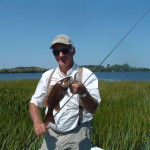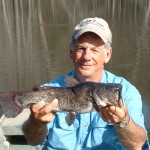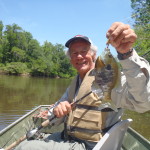Fact of life – if you fish much you will get hooks stuck in you. From little pin-pricks on fingertips to hooks buried in ears, arms and even bellies, hooks end up in all the wrong places. It will happen.
One experience was funny, to everyone except my Uncle Mayhue. Three of us were fishing from a 12 foot jon boat at Usury’s Pond in McDuffie County. That is a prescription for disaster, especially if one of the fishermen is only eight years old. Uncle Adron was in the middle of the boat and I was in the back. Uncle Mayhue was in the front sculling the boat along while all three of us cast plastic worms with three hooks in them.
I have no doubt both uncles were watching me and trying to make sure I didn’t do anything to cause a problem, but Uncle Adron should have been looking forward more. On one cast he somehow hooked Uncle Mayhue in the ear with his plastic worm – with all three hooks.
I tried not to laugh but it was funny. The red Crème worm outlined the ear while a few drops of blood trickled out. Not one to let such a small thing stop him from fishing, Uncle Mayhue just kept on casting, saying he would get it out later. Uncle Adron had to cut his line and rig up another bait.
When I was about 15 years old I was fishing at Clark’s Hill by myself in our big ski boat. It was a hot day and I had my shirt off. I cast a Little Cleo spoon toward the bank and got hung in a bush. When I snatched it to pull it out of the bush my plan worked too well. I suddenly felt a sting on my stomach, looked down and saw one of the hooks on the treble was out of sight with the other two pressed tight against my stomach.
I did not have a protective coating over my stomach back then like I do now, and I knew from my little memory of biology that there were some pretty important things not too far under the skin in that area. I cut the line off and drove the boat back to the dock.
My mom was fishing under the dock and when I tied the boat up and pointed to the spoon I almost passed out. It did not hit me till then. She took me to the emergency room and they cut the hook out and it took only two stitches to close the cut up. The doctor told me I was not really in any danger, the layer of muscle – back then, anyway – was much thicker than the hook was long.
That and other experiences taught me to get the hooks out of myself. One beautiful fall day while fishing at Lake Martin I was casting a big DBIII crankbait to shallow cover. When the lure bumped a log I thought I got a strike and set the hook. The plug came flying through the air and ended up hanging from my upper arm, just below my shirt sleeve.
It didn’t really hurt, just felt like someone had punched me in the arm. I told my partner to grab the visible hooks with a pair of pliers and jerk the hook out. I warned him to do it fast, to please not pull slowly because that hurt a lot more.
He took the pliers, looked at the plug and all the color drained from his face. He couldn’t do it. So I did. I took the pliers, jerked the lure loose and went back to casting it. It never bled or hurt. I have found that often works best. Just jerk the hook out quickly and get back to fishing.
If you are fishing saltwater on the Gulf of Mexico you had better be careful of any injury like that, though. Especially this time of year there is a bacterium that lives in the water that can be deadly. It is more common late in the summer and will enter your body through any hole like those made by hooks, fish fins and knife cuts. It can even get in through a scrape.
A few years ago a friend of mine, Kevin Dallmier, who was a fisheries biologist from north Georgia, got one of these infections. The bacterium, Vibrio vulnificus, can lead to amputations and even death. Kevin was in the hospital for several weeks recovering from his infection.
You are more likely to get an infection if your immune system is weak. But be careful anyway. There are about 40 confirmed cases each year on the US Gulf Coast, not many unless you happen to be one of them. A high percentage of confirmed cases, 35, require hospitalization and almost one third, or 12 per year, result in death.
Be careful when fishing. And if you get an injury from a hook or anything else, get medical attention if you start running a fever. Don’t wait to hope it will go away.



